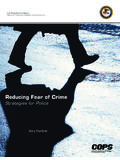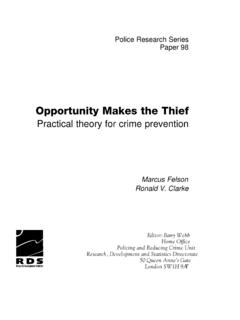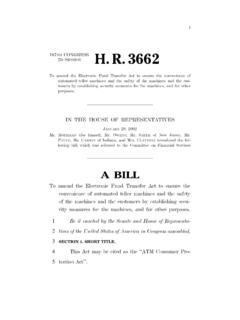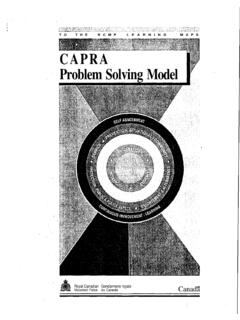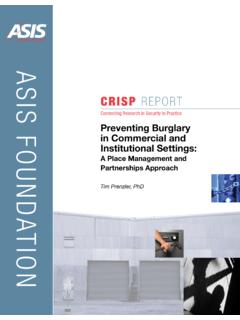Transcription of COMMUNITY ORIENTED POLICING PROBLEM …
1 COMMUNITY ORIENTED POLICING & PROBLEM SOLVING>" C. 0. P. P. S."RICHARD KIRKLAND, CHIEF OF POLICECONTENTSA cknowledgementsPrefaceI COMMUNITY ORIENTED POLICING and PROBLEM SolvingII January 1992 Citizen Attitude and Opimon SurveyHI Mini-Surveys-Central Area Day Shift-Traffic Citations-Work Cards-Animal ControlACKNOWLEDGEMENTSThis publication is a result of the men and women of the Reno Police Department whosededicated service during a difficult period of diminishing resources, increased demands forservice and a rapidly changing environment, transformed our COMMUNITY POLICING philosophyinto a successful and meaningful police service delivery success of this program cannot be mentioned without including the efforts of ourcommunity. In particular, one of our most involved citizens, Dorothy Newberg, whoseleadership in the "Safety 88 Campaign" resulted in the voters approval for 88 new , more than 750 COMMUNITY and business members are actively involved inNeighborhood Advisory Groups in an effort to resolve COMMUNITY program of this magnitude would not be possible without the substantial support of our CityManager, Clay Holstine and members of the City Council.
2 They have and continue toencourage our efforts to form COMMUNITY partnerships and improve police service throughoutthe are additionally grateful to Dr. Ken Peak, Criminal Justice Department Chairman at theUniversity of Nevada-Reno for his enthusiasm, encouragement and assistance in publishingsegments of our program. Also, Dr. Rosalee Marinelli, Sandra Neese and Mike Havercampfrom the Center for Applied Research at the University of Nevada-Reno for their critical reviewand contributions to the design and methodology of our survey to ensure its validity individuals who contributed to the writing of this manual cannot go without Chief Ron Glensor, who completed the majority of writing for this manual and managesour COMMUNITY survey program, and Steve Bigham, the department's statistician assigned toQuality Assurance, who conducts the surveys, analyzes its results and converts complexstatistical information into understandable data to assist my staff with decision-making andproblem , our appreciation is extended to Darrel W.
3 Stephens, Executive Director of the PoliceExecutive Research Forum, for his editorial assistance and encouragement to tell "Reno'sStory."PREFACEThis manual, " COMMUNITY ORIENTED POLICING and PROBLEM Solving", describes the Reno PoliceDepartment's experience in the transition from a traditional law enforcement design toCommunity many other cities, Reno is faced with a complex environment consisting of fiscalconstraints, rapid change, high technology, added demands for service, increased litigation andthe need for cultural sensitivity. These challenges, and more, have required the policedepartment to reassess its role in the COMMUNITY and its methods of delivering public program began on the premise that the COMMUNITY is the key element in our attempt to curbcrime and resolve neighborhood problems.
4 This approach resulted in our development ofNeighborhood Advisory Groups (NAG's) that work with area commanders and officers atidentifying and resolving neighborhood concerns. Our experience with NAG's has proven verysuccessful and has improved the overall satisfaction of both the COMMUNITY and solving is the backbone of our COMMUNITY POLICING efforts. All our officers have beentrained in the concepts of PROBLEM ORIENTED POLICING (POP) and, as a result, actively work theirown projects throughout the order to properly evaluate our success, we created a major COMMUNITY Opinion Survey in1987. We continue to implement this survey every six months. It serves as a "report card"from residents and provides us with information about our performance, image, public fear,concerns about crime and quality of contact department members.
5 The surveys provide valuableinformation that improves our ability to make decisions of an operational and policy nature. Theresults of each survey are shared with the COMMUNITY and officers so they better understand theirrelationship with one another and how effective that relationship is at mutually solving believe COMMUNITY POLICING is the future of POLICING and an evolution of our past"Wisdom." It holds the greatest potential for effectively dealing with our current environmentand future document was created to stimulate interest and present our experience in dealing moreeffectively with the citizens and visitors to Reno. To date, we have answered over 150 writteninquiries about our program and entertained over 30 site visits by other agencies. If we can bea resource to any individual, group, police department, or city interested in undertaking suchan endeavor, we offer our assistance, experience, and KirklandChief of PoliceCommunity ORIENTED PolicingandProblem SolvingDeputy Chief Ronald W.
6 GiensorJanuary 1992 INTRODUCTIONIn June 1987, after the public, for the second time in two years, struck down a taxinitiative that would have replenished depleting resources and personnel, a COMMUNITY Attitudeand Public Opinion Survey conducted by the Reno Police Department (RPD) revealed it had aserious image PROBLEM . Survey data revealed that citizens were generally pleased with thedepartment's overall performance, but were displeased with its tactics, which they described as"uncaring and heavy handed."At the time, the Reno Police Department was driven by a Management by Objectives(MBO) philosophy. MBO had provided administrators the capability to track the department'sperformance through established goals and objectives. Unfortunately, high numbers of arrestsand citations were equated to successful productivity. As a consequence, efficiency had replacedeffectiveness, standardization took priority over creativity, and performance was based solelyon the department's ability to achieve established objectives.
7 Statistics became the driving forceand although objectives were accomplished, the department's image suffered in the eyes of situation was made worse by the passage of a property tax law in 1980 that wassimilar to California's Proposition 13. It established a property tax cap allowing onlyincremental annual increases of four and one-half percent. The City of Reno had relied heavilyon property tax revenues and the new legislation resulted in immediate budget reductions andpublic service cuts. For the next six years, the police department suffered significant personneland equipment the same time, jurisdiction increased from 38 to 59 square miles, calls for service(CFS) increased annually by 8 percent, and population continued on a steady rise from 102,000to 121,000 residents. The situation had deteriorated to a critical state.
8 Police administratorswere convinced the solution to the PROBLEM rested on the department's ability to reverse its poorimage in the an effort to re-unite the police with the COMMUNITY , a new management philosophybased on close police/ COMMUNITY interaction was implemented. During the 1980's, CommunityOriented POLICING was gaining popularity with many municipalities. Reno 's model,originally named COMMUNITY ORIENTED POLICING -Plus (COP+), was designed to improve policeservice and solve problems through an interactive process with the COMMUNITY . Within a yearafter COMMUNITY POLICING was implemented, voters approved a long-sought tax initiative thatauthorized the hiring of 88 new officers. Subsequent surveys revealed a marked improvementin the department's performance and image in the January 1992, Richard Kirkland was appointed as Reno's new Chief of Police.
9 Underhis direction, the department's program was renamed " COMMUNITY ORIENTED POLICING andProblem Solving" (COPPS). The name was changed to emphasize the importance of problemsolving in the department's COMMUNITY POLICING document begins with an explanation of the basic tenants of COMMUNITY Policingand PROBLEM Solving. It then provides a detailed look at the organization, implementation anddistinctive elements of Reno's COPPS PRINCIPLES OF COMMUNITY POLICING AND PROBLEM SOLVINGFor the past three decades our society has fallen victim to a dramatic increase in crime,gangs and drugs. Research on preventive patrol, rapid response, crime prevention and detectiveshas questioned the effectiveness of traditional POLICING strategies. It was learned that 8 of 10calls for service were related more to quality of life concerns than crime (Johnson, 1981).
10 Themyth that the principle police function involved combatting crime and arresting evildoers wasquickly fading. These studies convinced police leaders to re-evaluate traditional strategies whichhad been proven to be tenets of COMMUNITY POLICING and PROBLEM solving have appeared in the literature forseveral decades but the terminology and application of these strategies was not commonly knownuntil the mid-1980's. Three benefits are commonly associated with these new theories:* Improved delivery of police service* Improved police/ COMMUNITY relations* Mutual resolutions to identifiable problemsCommunity POLICING has been referred to as the most significant contribution to policingin this century. As a professor of Michigan State University stated, "This is the cutting edgeof POLICING in America today" (Carter, 1989).
